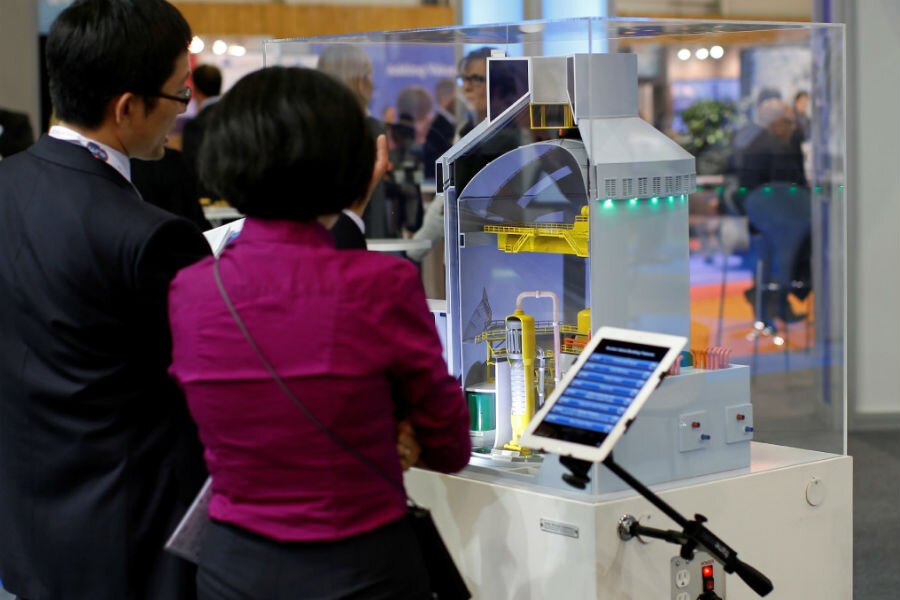Westinghouse bankruptcy: What does it mean for US nuclear power?
Loading...
One of the biggest players in the nuclear power game has taken a step back, raising questions about the future of nuclear power in the United States.
On Wednesday, Westinghouse Electric, Toshiba’s nuclear unit in the US, filed for Chapter 11 bankruptcy. As part of its bankruptcy restructuring, the Pennsylvania-based company plans to stop installing reactors in order to focus on maintenance and design, a decision that throws into doubt the future of four reactors that are under construction.
For some, the challenges are a sign of systemic problems that mean nuclear power generation should be phased out. The Westinghouse bankruptcy “is a powerful signal of the end of the fantasy of a nuclear revival,” writes Daniel Hirsch, director of the Program on Environmental and Nuclear Policy at the University of California, Santa Cruz, in an email to The Christian Science Monitor.
Others see the bankruptcy filing as another short-term challenge to a beleaguered industry, but they predict a nuclear resurgence down the line. “The Westinghouse bankruptcy is a setback, but I expect it will only be a temporary setback,” writes Steven Biegalski, director of the Nuclear Engineering Lab at the University of Texas at Austin, in an email to The Christian Science Monitor. “The United States and world need nuclear power to meet the global growth in demand for electricity.”
Westinghouse is responsible for technology used in about half of the world’s nuclear power plants. When Toshiba purchased the company for $5.4 billion in 2006, it expected Westinghouse to be a lucrative sideline to its consumer electronics business. But delays on the four nuclear reactors it was constructing in the US, combined with increased regulation after the Fukushima nuclear accident in 2011 that forced changes to reactor design, left the company in the red.
Nor is Westinghouse the only struggling nuclear player. General Electric has also scaled back its nuclear development, while France’s Areva is restructuring, The New York Times reported.
Critics have long been concerned about the risks associated with nuclear power, chiefly the potential for accidents and production of radioactive waste. The Westinghouse bankruptcy reinforces that cost is also a concern, says M.V. Ramana, a professor at the University of British Columbia in Canada.
“This is the fundamental challenge that nuclear power has faced for the past several decades,” he tells the Monitor in a phone interview, arguing that nuclear power is “unable to compete economically in the electricity marketplace.” Nor are the construction cost overruns and time delays that have plagued the Westinghouse projects unique to the US, he adds.
These observers suggest that it is time for the US to focus its attention on renewable energy sources, including wind and solar. But others take a more optimistic view of nuclear energy’s long-term potential, saying the current challenges can be addressed.
That may start with strengthening domestic industry. Before Westinghouse signed on to the four nuclear projects in 2008, no new nuclear plants had been built in the US since the Three Mile Island accident in 1979, and Westinghouse’s contractors’ lack of expertise seems to be largely responsible for costly delays.
“It was clear early on that the US had lost much of its skilled workforce needed to build the power plants,” explains Paul Dickman, who is on the board of directors of the American Nuclear Society and is a retired senior official at the Nuclear Regulatory Commission, in an email to the Monitor. "Lack of experience on all sides was certainly a factor and there were many issues that had to work themselves out."
Smaller reactors may also provide an alternative to traditional large-scale projects.
And while the upfront costs of nuclear installations may still concern energy companies, Dr. Biegalski notes, nuclear may look more appealing down the road.
“In the short-term, the low cost of natural gas in the United States and subsidized solar and wind create an energy market where nuclear does not shine as well as it should,” he writes. “However, it is expected that the low cost of natural gas and the solar and wind subsidies are not long-term features of our market.”
Investors may not be so easily swayed, however. As Dr. Carey King, an assistant director at the Energy Institute at the University of Texas at Austin, tells the Monitor in an email, wind and solar “can be installed in smaller increments, putting less total capital at risk at one time.”
Both advocates and detractors of nuclear energy suggest that their approach is the United States’s best hope for curbing carbon emissions.
“If the US gets serious about reducing emissions, you must have massive investments in dozens of new nuclear plants,” Mr. Dickman writes.
Jacopo Buongiorno, a professor of nuclear science and engineering at the Massachusetts Institute of Technology, concurs, noting the limited timeframe for transitioning away from fossil fuels.
“If you look at countries that have brought low-carbon electricity generation online fast, they’ve all done it with nuclear,” he tells the Monitor.
But Professor Ramana says nuclear may not need to be part of the mix. Since each renewable source is productive at different times, it should be possible to produce a blend of renewable energy sources that “compensate for [each other’s] intermittencies,” he suggests.








